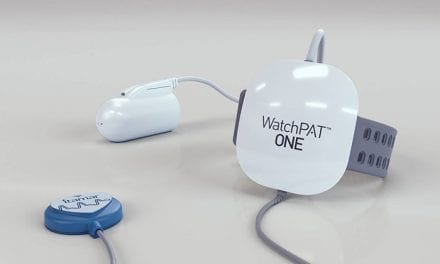ApniCure Inc, a medical device company focused on developing and commercializing novel home-use devices for the treatment of obstructive sleep apnea (OSA), presented additional positive results from the ATLAST trial of its Winx Sleep Therapy System in patients with obstructive sleep apnea.
Study results demonstrated that Winx significantly improved the severity and symptoms of OSA, was safe and well tolerated, and was associated with high nightly usage and patient satisfaction. These clinical data, along with results from another analysis of the ATLAST study demonstrating improvements in sleep architecture and sleep stability with Winx therapy, were presented at the 21st Congress of the European Sleep Research Society (ESRS) in Paris.
The Winx system is designed to offer a comfortable sleeping experience, allowing users to breathe naturally without a mask. Winx uses a proprietary platform technology called oral pressure therapy (OPT) to treat OSA. OPT is a light, oral vacuum delivered by a quiet console through a slim tube connected to a soft mouthpiece. The mouthpiece and vacuum work together to gently pull the soft palate forward and stabilize the tongue, increasing the size of the airway and allowing for natural breathing to occur during sleep.
The multicenter, prospective ATLAST study examined the safety, effectiveness, and tolerability of the Winx system in 63 patients (44 men and 19 women) ages 32 to 80 with mild, moderate, or severe OSA, with or without prior CPAP use. Study participants underwent laboratory polysomnography at baseline with and without Winx treatment and again following 28 nights of treatment with Winx to determine apnea-hypopnea index (AHI) and oxygen desaturation index (ODI). ODI and AHI were calculated using American Academy of Sleep Medicine criteria by a blinded scorer. OSA symptoms were assessed with the Epworth Sleepiness Scale (ESS) and a modified Functional Outcomes of Sleep Questionnaire (mFOSQ). Nightly usage of Winx was assessed objectively by the Winx system console, which collected data on a standard data card.
Earlier findings from the ATLAST study were presented at the 2012 American Thoracic Society (ATS) Conference in May. The new and updated findings, based on data from 63 patients, show that Winx significantly reduced AHI, ODI, and symptoms of OSA after 28 days. Median ESS scores were unchanged in patients who switched directly from CPAP therapy to Winx therapy and were significantly reduced in those untreated for 2 or more weeks prior to Winx study participation. A substantial proportion of patients (41.3%) met the prospectively defined clinical success criteria (AHI reduction >50% and treatment AHI <20). These patients were easy to identify and included those with mild, moderate, and severe OSA.
Compliance with the Winx system was high, with nightly usage high in both frequency and duration. Study participants used the system 6 hours each night (median), and the median percentage of nights with more than 4 hours of use was 88.9%. Study participants had a high opinion of Winx, with 76% indicating that they would use the system to treat their OSA. In the study, Winx was safe and well tolerated, with no severe or serious device-related adverse events.
Winx treatment also was shown to be compatible with current clinical practice due to features such as in-lab mouthpiece fitting, objective compliance monitoring, and compatibility with polysomnography systems.
Additional analysis of data from the ATLAST study evaluated the effect of Winx therapy compared with nontreatment on the sleep architecture and sleep stability of study participants. Polysomnographic sleep measures, including arousal index, sleep-stage shifts, and duration of sleep stages, were evaluated in 63 patients.
Results showed that the significant improvements in AHI produced by Winx were associated with increased sleep stability, significantly decreased time in non rapid eye movement (NREM) stage 1 sleep, and increased time in rapid eye movement (REM) sleep on both the first night of treatment and again after 28 days of treatment. Shifts to stage 1 sleep, overall stage shifts, total awakenings, and arousals per hour were all significantly decreased with Winx.



